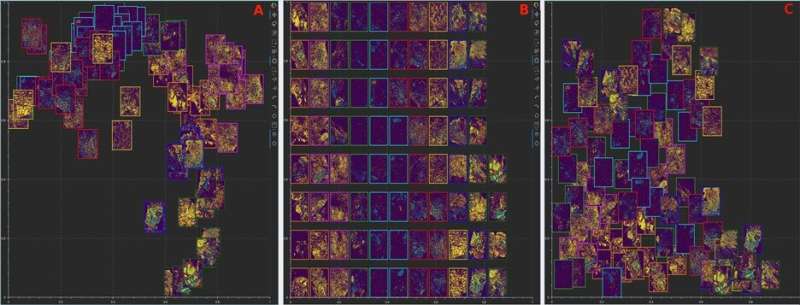Developing software that allows simultaneous viewing of tissue images through dimensionality reduction

Imaging of tissue specimens is an important aspect of translational research that bridges the gap between basic laboratory science and clinical science to improve the understanding of cancer and aid in the development of new therapies. To analyze images to their fullest potential, scientists ideally need an application that enables multiple images to be viewed simultaneously. In an article published in the journal Patterns, Moffitt Cancer Center researchers describe a new open-source software program they developed that allows users to view many multiplexed images simultaneously.
There have been significant improvements in the approaches to study cancer over the past decade, including new techniques to study tissue samples. For example, machines can now be programmed to stain hundreds of slides simultaneously, or alternatively, up to 1,000 different tissue sample cores can be placed on a single slide and stained for biomarkers at the same time. With the advent of these approaches comes a wealth of possibilities to generate new data and information. Due to the magnitude of this information and the complex nature of cancer itself, computational modeling and software are needed to view and study the cancer biomarkers, tissue architecture, and cellular interactions among these samples.
As researchers in Moffitt’s Integrated Mathematical Oncology Department (IMO) were working on a project, they realized that the currently available software for image viewing was not amenable to their needs.
“We were interested in understanding the underlying spatial patterns between tumor and immune cells and how the tumors were organized. This required us to compare multiple images simultaneously and we realized there was no software, free or commercial, enabling this,” said Sandhya Prabhakaran, Ph.D., lead author and applied research scientist at Moffitt.
The IMO team decided to create a software program that would enable them to view multiple images at the same time and extract data through additional analyses that could be used for a variety of purposes, including identifying biomarkers and understanding tissue architecture and the spatial organization of different cell types. Their program, called Mistic, takes information from multidimensional images and uses dimensionality reduction methods called t-distributed stochastic neighbor embedding (t-SNE) to abstract each image to a point in reduced space. Mistic is an open-source software that can be used with images from Vectra, CyCIF, t-CyCIF and CODEX.
In their publication, the researchers describe the creation of Mistic and some of the applications that it could be used for. For example, they demonstrated that the software could be used to view 92 images from patients with non-small cell lung cancer and deduce how biomarkers cluster across patients with different responses to treatment. In another example, the researchers used Mistic combined with statistical analysis to assess the spatial colocalization and coexpression of immune cell markers in 210 endometrial cancer samples.
The team is excited about the potential applications for Mistic and have plans to improve the software.
“We will enhance Mistic to use biologically meaningful regions of interest from the multiplexed image to render the overall image t-SNE. We also have plans to augment Mistic with other visualization software and build a cross-platform viewer plugin to improve the adoption, usability and functionality of Mistic in the biomedical research community,” said Sandy Anderson, Ph.D., author and chair of Moffitt’s IMO Department.
Source: Read Full Article
